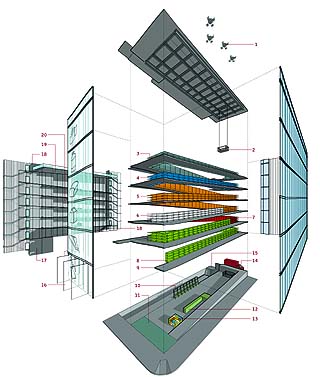
Surveys
DJC.COM
November 18, 2004
Peering into the future of urban supermarkets
NBBJ

Image courtesy NBBJ
The concept for Foodhive includes organizing goods according to the food pyramid. Click here for a larger view.
|
As the popularity of urban living grows, so does the need for domestic staples. Downtown dwellers typically have access to an abundance of coffee shops and nightspots, but when it comes to feeding the family, stocking the shelves with milk, eggs and cheese can become an exercise in futility.
Grocery stores beyond the occasional mom-and-pop corner shop are most often a bus ride or car trip away for most inner-city residents. And when many who live downtown have shed their vehicles in exchange for the pedestrian experience, stocking up on staples becomes inconvenient at best.
The high cost of real estate and density of urban cores typically drive supermarket executives away from city centers and instead to suburban sites that can more easily accommodate the traditional one-level grocery store layout.
But what if all that changed? What if developers considered moving up instead of out? What if retailers abandoned preconceived notions about space and design, and instead took a chance on a new way of doing business?
Then "Foodhive" might become more than just an idea waiting to happen.
What's the buzz about?
Given an invitation to design a grocery store of the future, two architects, two retail specialists, a marketer and a graphic designer — all from NBBJ — joined forces to conceptualize an urban grocery venue that could make picking up a gallon of milk as simple as buying a double-tall latte at Starbucks. The exploration of costs, site locations and tenants was set aside, with the focus instead placed on creativity and innovation.
The team's creation: Foodhive — an urban-friendly grocery store on a half-block footprint that uses a continuous ramp, circling around a center void, to create six uninterrupted levels of shopping. Think of a cross between a QFC and downtown Seattle's new Central Library.
The 50-foot-high, 120-foot-deep and 75-foot-tall grocery store is capped by a rooftop garden and cafe.
Manipulative marketing is abandoned; the store's goods instead organized according to the food pyramid or other principals. A "quick shop" is located on the main floor, where shoppers can pick up popular items such as bread and milk instead of following the ramp to the particular areas.
The use of emerging technologies creates a clean and direct shopping experience. Radio-frequency food tagging keeps a running tally of a shopper's selections while also facilitating checkout, as a shopper's account is charged upon crossing the transaction vestibule. If it works for cars on the turnpike, then why not for bananas at the supermarket?
Customers can shop in a variety of ways, including conventionally. Orders can be made online, then groceries picked up by the customer or delivered by the store to their apartment or condominium. No longer will shoppers have to lug bags of groceries through the city's busy core.
Though currently little more than an expanded concept, Foodhive embodies a number of conveniences and technologies that could easily combine to change the way downtown Seattle shops. And make it a whole lot easier to pick up tonight's dinner ingredients on your way home from work.
Andrew McCune and Blaine Brownell are associate architects at Seattle design firm NBBJ.
Other Stories:
- A new Rx for emergency room design
- Preparing the next design pioneers
- A new tool for analyzing seismic hazards
- Don't sacrifice green design to 'value engineering'
- How buildings can help 'reforest' a city
- Opportunities abound in China for A/E firms
- What owners need to know about seismic design
- Unique design brings Boeing workers together
- Ready to go national with your design firm?
- A/E firms look to plastic for growth
- Skinner Building gets a seismic skeleton
- Waterlogged walls? New system will tell you
- Designers — beware of technology convergence
- A past blast: building the road to St. Helens
- Commissioning squeezes the best out of buildings
- Designers have lofty aspirations for housing
Copyright ©2009 Seattle Daily Journal and DJC.COM.
Comments? Questions? Contact us.